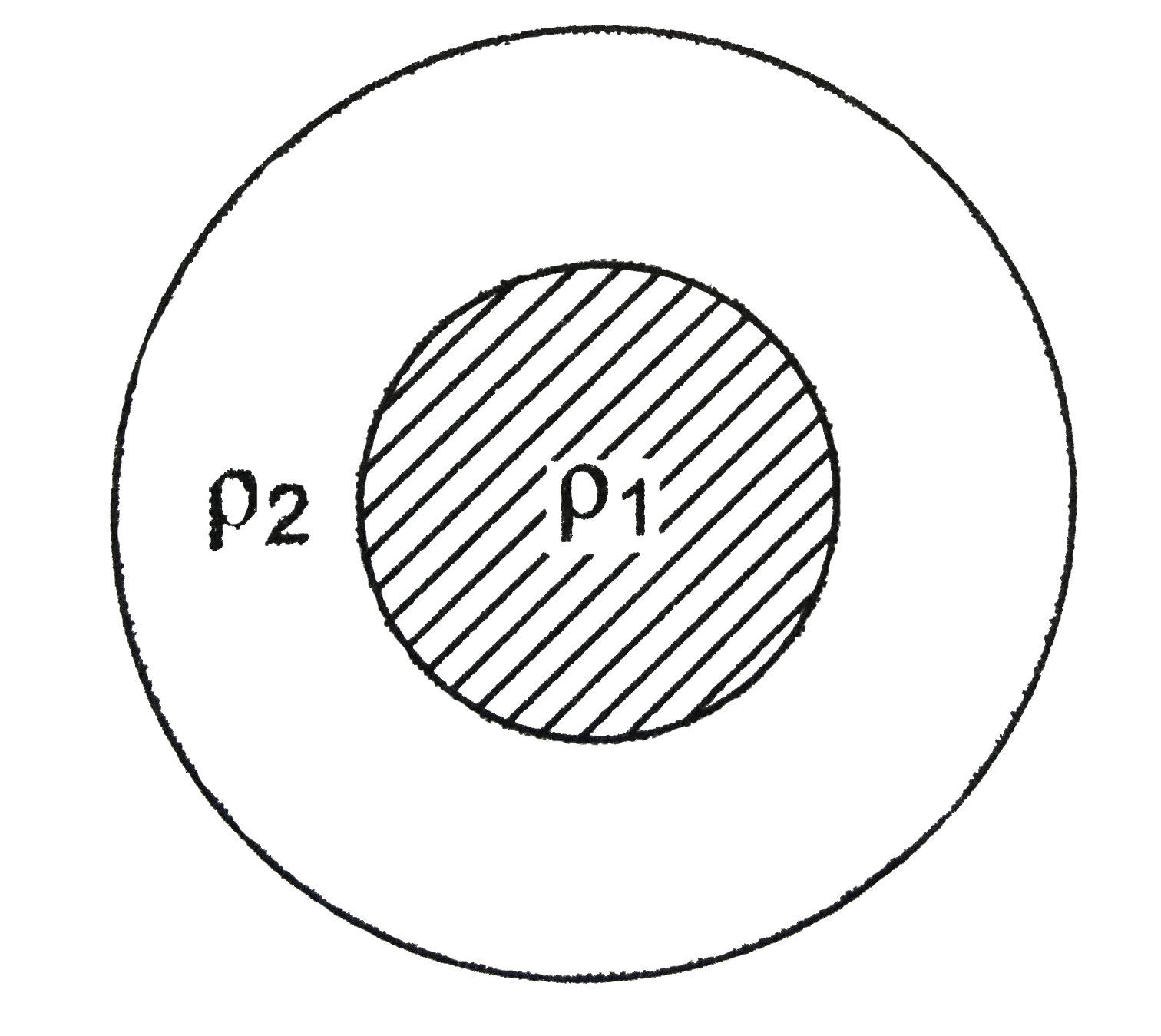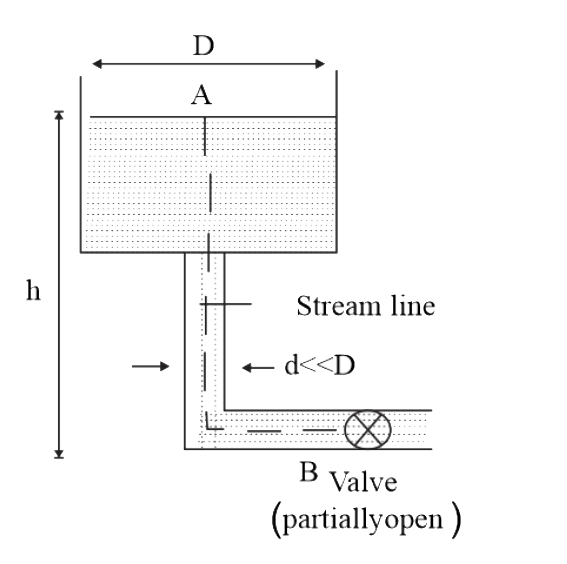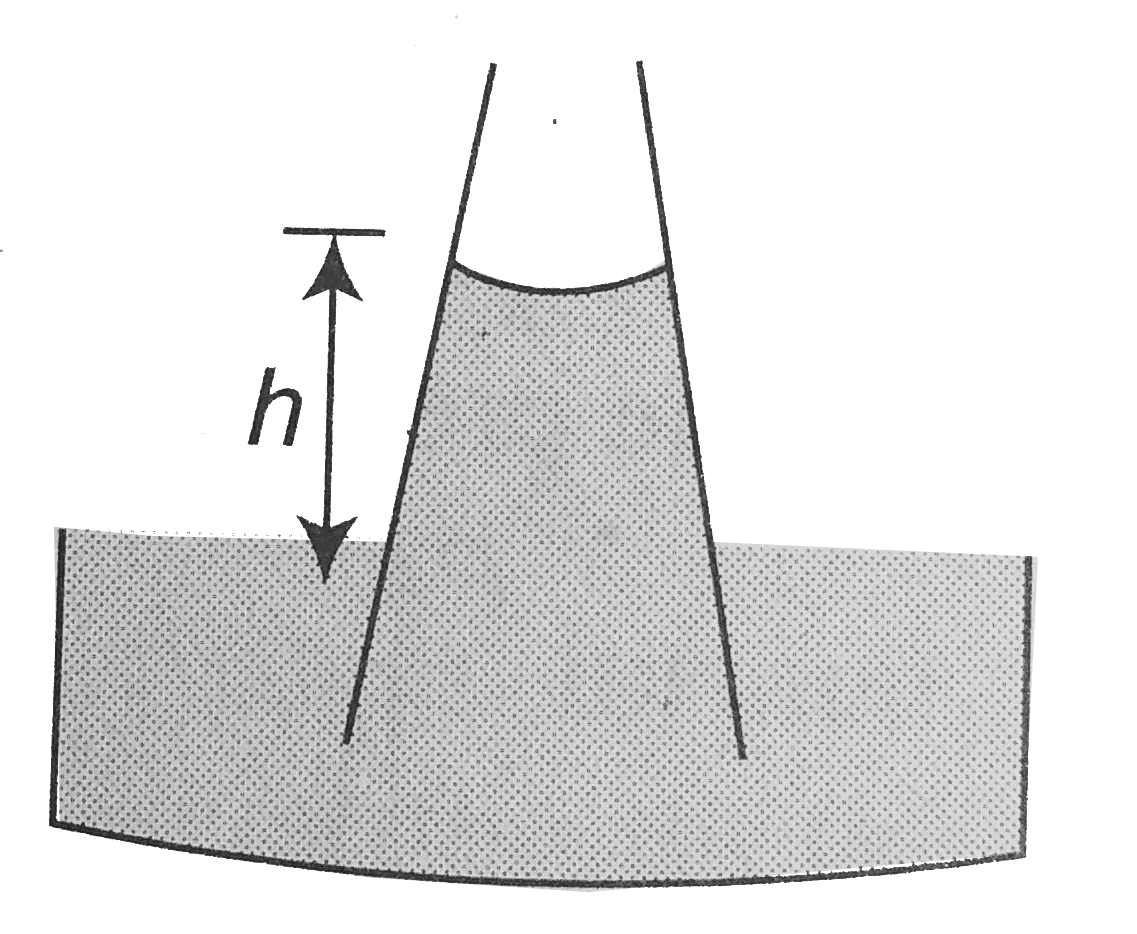The Bernoulli's equation is given by P+12ρv2+hρg=k. Where P= pressure, ρ= density, v= speed, h=height of the liquid column, g= acceleration due to gravity and k is constant. The dimensional formula for k is same as that for:
Velocity gradient
Pressure gradient
Modulus of elasticity
Thrust
The correct Answer is:C
To find the dimensional formula for k in Bernoulli's equation, we start by analyzing the equation itself:
P+12ρv2+ρgh=k
Where:
- P = pressure
- ρ = density
- v = speed
- h = height of the liquid column
- g = acceleration due to gravity
- k = constant
Step 1: Determine the dimensions of each term in the equation.
1. Pressure (P):
- Pressure is defined as force per unit area.
- The dimensional formula for force is (MLT−2) (mass × acceleration).
- The area has the dimensional formula (L2).
- Therefore, the dimensional formula for pressure is:
(P)=(MLT−2)(L2)=(ML−1T−2)
2. Kinetic Energy Density (12ρv2):
- The term 12 is a constant and does not affect dimensions.
- Density (ρ) has the dimensional formula (ML−3).
- Speed (v) has the dimensional formula (LT−1).
- Therefore, v2 has the dimensional formula (L2T−2).
- Now, the dimensional formula for ρv2 is:
(ρv2)=(ML−3)⋅(L2T−2)=(ML−1T−2)
3. Potential Energy Density (ρgh):
- The acceleration due to gravity (g) has the dimensional formula (LT−2).
- Height (h) has the dimensional formula (L).
- Therefore, the dimensional formula for ρgh is:
(ρgh)=(ML−3)⋅(LT−2)⋅(L)=(ML−1T−2)
Step 2: Combine the terms.
Since all the terms P, 12ρv2, and ρgh have the same dimensional formula (ML−1T−2), we can conclude that:
k must also have the same dimensional formula as these terms.
Step 3: Conclusion.
Thus, the dimensional formula for k is:
(k)=(ML−1T−2)
Step 4: Compare with the options.
Now, we need to check which of the given options has the same dimensional formula as k.
1. Velocity Gradient: This has dimensions of (T−1) which is not the same as (ML−1T−2).
2. Pressure Gradient: This has dimensions of (ML−2T−2) which is not the same as (ML−1T−2).
3. Modulus of Elasticity: This has dimensions of (ML−1T−2) which is the same as k.
4. Thrust: This has dimensions of (MLT−2) which is not the same as (ML−1T−2).
Final Answer:
The correct option is C: Modulus of Elasticity.
---
- P = pressure
- ρ = density
- v = speed
- h = height of the liquid column
- g = acceleration due to gravity
- k = constant
- Pressure is defined as force per unit area.
- The dimensional formula for force is (MLT−2) (mass × acceleration).
- The area has the dimensional formula (L2).
- Therefore, the dimensional formula for pressure is:
(P)=(MLT−2)(L2)=(ML−1T−2)
- The term 12 is a constant and does not affect dimensions.
- Density (ρ) has the dimensional formula (ML−3).
- Speed (v) has the dimensional formula (LT−1).
- Therefore, v2 has the dimensional formula (L2T−2).
- Now, the dimensional formula for ρv2 is:
(ρv2)=(ML−3)⋅(L2T−2)=(ML−1T−2)
- The acceleration due to gravity (g) has the dimensional formula (LT−2).
- Height (h) has the dimensional formula (L).
- Therefore, the dimensional formula for ρgh is:
(ρgh)=(ML−3)⋅(LT−2)⋅(L)=(ML−1T−2)
2. Pressure Gradient: This has dimensions of (ML−2T−2) which is not the same as (ML−1T−2).
3. Modulus of Elasticity: This has dimensions of (ML−1T−2) which is the same as k.
4. Thrust: This has dimensions of (MLT−2) which is not the same as (ML−1T−2).
Topper's Solved these Questions
- BOOK - VMC MODULES ENGLISHCHAPTER - UNITS, MEASUREMENTS & ERRORSEXERCISE - Impeccable51videos
UNITS, MEASUREMENTS & ERRORS
- BOOK - VMC MODULES ENGLISHCHAPTER - UNITS, MEASUREMENTS & ERRORSEXERCISE - Illustration24videos
UNITS, MEASUREMENTS & ERRORS
- BOOK - VMC MODULES ENGLISHCHAPTER - UNITS, MEASUREMENTS & ERRORSEXERCISE - Enable50videos
UNITS, MEASUREMENTS & ERRORS
- BOOK - VMC MODULES ENGLISHCHAPTER - SYSTEM OF PARTICLES AND ROTATIONAL MOTIONEXERCISE - IMPECCABLE56videos
SYSTEM OF PARTICLES AND ROTATIONAL MOTION
- BOOK - VMC MODULES ENGLISHCHAPTER - WAVE MOTIONEXERCISE - JEE ADVANCED ARCHIVE LEVEL 2 (TRUE FALSE TYPE)4videos
WAVE MOTION
Similar Questions
If pressure P, velocity of light c and acceleration due to gravity g are chosen as fundamental units, then dimensional formula of mass is
View SolutionIf pressure P, velocity of light C and acceleration due to gravity g are chosen as fundamental units, then dimensional formula of mass is
View Solution
Knowledge Check
- Question 1 - Select One
The radii of two planets are respectively R1andR2 and their densities are respectively ρ1andρ2.The ratio of the accelerations due to gravity at their surface is
AR1ρ2R2ρ1BR1ρ1R2ρ2Cρ1R22ρ2R21DR1R2ρ1ρ2 - Question 2 - Select One
The density of the core a planet is ρ1 and that of the outer shell is ρ2. The radii of the core and that of the planet are R and 2R respectively. The acceleration due to gravity at the surface of the planet is same as at a depth R. Find the ratio of ρ1ρ2
 A2.3B4.5C3.2D5.4
A2.3B4.5C3.2D5.4
According to Bernoullis theoram pd+v22+gh = constant, dimensional formula of the constant.
View SolutionA storage tower supplies water, as shown in the figure. If P0 is the atmospheric pressure h = height of water level, g = acceleration due to gravity, ρ= density and v = velocity of flow in the horizontal pipe at B, then the pressure at B is -
 View Solution
View SolutionThe absolute pressure at a depth h below the surface of a liquid of density ρ is [Given Pa = atmospheric pressure, g = acceleration due to gravity]
View SolutionThe density of the core a planet is ρ1 and that of the outer shell is ρ2. The radii of the core and that of the planet are R and 2R respectively. The acceleration due to gravity at the surface of the planet is same as at a depth R. Find the radio of ρ1ρ2
 View Solution
View SolutionThe density of the core a planet is ρ1 and that of the outer shell is ρ2. The radii of the core and that of the planet are R and 2R respectively. The acceleration due to gravity at the surface of the planet is same as at a depth R. Find the ratio of ρ1ρ2
 View Solution
View Solution
A capillary of the shape as shown is dipped in a liquid. Contact angle between the liquid and the capillary is 0∘ and effect of liquid inside the mexiscus is to be neglected. T is surface tension of the liquid, r is radius of the meniscus, g is acceleration due to gravity and ρ is density of the liquid then height h in equilibrium is:View Solution
